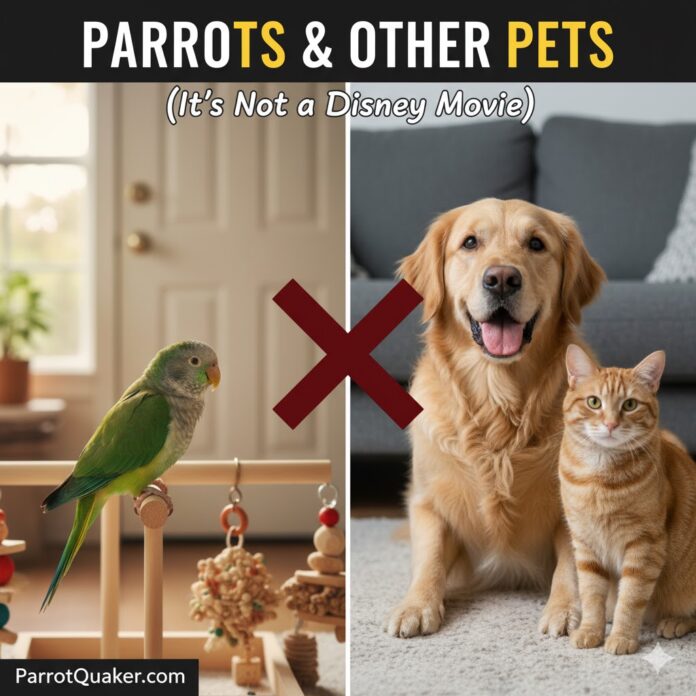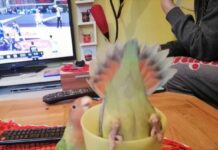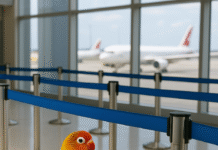I used to have this idyllic picture in my head. You know the one. The golden retriever is sleeping on the rug, the cat is curled up on the sofa, and the parrot is perched happily on the dog’s head. Everyone is smiling. The sun is shining.
Then I actually got a parrot, and I realized that picture is dangerous.
If you are reading this, you probably already have a “zoo” in your house or you are thinking about building one. I get it. I love animals, and it is hard to stop at just one species. But mixing parrots with other pets is stressful. It requires a level of vigilance that most people, honestly even myself on a tired Tuesday, are not always prepared for.
We need to talk about the reality of predator drive, bacteria, and why your bird might actually be the bully in the room.
The Cat and Dog Situation
Let us start with the big one. Most of us have cats or dogs. I have seen the cute videos on Instagram of birds preening cats. They make my stomach turn.
Here is the reality. Dogs and cats are predators. Parrots are prey.
It does not matter how sweet your Labradoodle is. It does not matter that your cat has “never hurt a fly.” Instincts are not something animals turn off because they love you. A dog can snap at a fluttering bird out of pure reflex. It is not aggression. It is just a “chase” instinct triggered by movement. That one snap is often fatal.
And cats? Cats are ambush predators. They are hardwired to hide their interest until the very last second. I wrote a whole piece specifically on whether you can keep Quakers with cats or dogs, and my stance is pretty firm. Keep them separated.
It is not just the teeth and claws you have to worry about. It is the spit.
Mammal saliva from cats, dogs, and humans contains gram-negative bacteria. Parrots have zero natural defense against this. If your cat just “plays” with the bird and nicks the skin, or your dog gives the bird a slobbery lick, that bacteria enters the bird’s system. It spreads fast. This is actually one of the common reasons parrots die suddenly. People think the bird is fine after a minor scuffle, and two days later, they are gone from septicemia.
If you have cats or dogs, you need physical barriers. You cannot just “watch them closely.” I am talking about door latches and sturdy cages that cannot be knocked over by an excited boxer.
The “Small Pet” Misconception
So, no cats or dogs. What about hamsters, guinea pigs, or rabbits?
They seem safer because they are not predators. That is mostly true. A guinea pig is not going to hunt your Conure. However, the danger here usually flips because the parrot becomes the problem.
Parrots are curious and their beaks are incredibly strong tools. A bird landing on a hamster cage can easily bite a toe through the bars. I have seen birds terrorize rabbits just because the rabbit moved and the bird got spooked or territorial.
Then there are ferrets. If you have a ferret, please do not let it near your bird. Ever. Ferrets are obligate carnivores with a high prey drive and flexible bodies that can get into cages. That is a tragedy waiting to happen.
Reptiles are a Hard No
I have had friends ask about keeping their lizard tank in the bird room.
The issue here is biology. Reptiles naturally carry Salmonella in their gut even when they are healthy. Birds are highly susceptible to Salmonella. You do not even need direct contact. If you handle your bearded dragon and then go change your parrot’s water bowl without scrubbing your hands like a surgeon, you are cross-contaminating.
Plus, snakes eat birds. Even if the snake is secure, the smell of a predator in the room causes chronic stress for a parrot. It is just not fair to them.
Bird on Bird: The Overlooked Danger
Ironically, the worst injuries I have seen have not been from cats. They have been from other birds.
We tend to think “birds like birds,” but different species communicate differently. A Quaker parrot is territorial. They are notorious for defending their cages. If a gentle Cockatiel lands on a Quaker’s cage, the Quaker might attack those toes without hesitation.
Size matters too. You cannot really have a Green Cheek Conure and a Macaw playing on the same stand unsupervised. The Macaw’s beak is designed to crack Brazil nuts while the Conure’s head is softer than a Brazil nut. Even a friendly nip from a large bird can be catastrophic for a small one.
If you look at how Sun Conures behave compared to other parrots, you realize that every species has a different “language.” Mixing them requires knowing those languages fluently.
Making it Work (Because We Do It Anyway)
Look, I am not telling you to rehome your dog. I live in a house with mixed species. I do not rely on trust though. I rely on systems.
- The “Two Door” Rule: There are always two doors between my bird and the outside world or the dog.
- Separate Playtime: When the bird is out, the dog is in the yard or crated. No exceptions. “Just for a second” is when accidents happen.
- Secure Housing: I invested in high-quality cages. Flimsy latches are a joke to a determined cat or a clever raccoon. You have to be serious about protecting them from dangers around the home.
It is possible to have a multi-pet household. It is not the Disney version. It is a lot of door-closing, hand-washing, and schedule-juggling. If you are willing to do the work, it is rewarding. If you are hoping they will all just “work it out,” you are gambling with your bird’s life.








